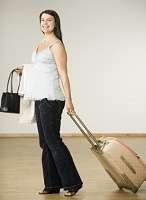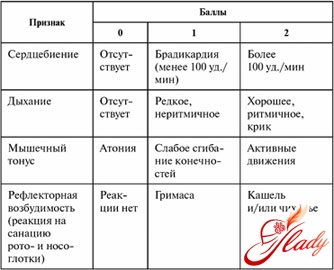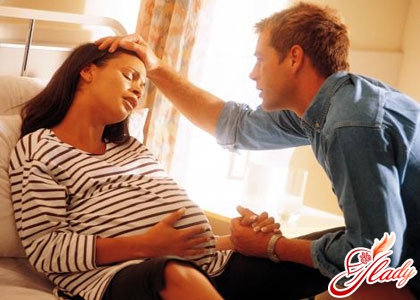 Perhaps at the end of pregnancy you had toto take a trip or you just for some reason were not ready for the beginning of labor. First of all, try to stay calm. Childbirth is a natural process, and women cope with it and outside the hospital walls. If you are on an airplane or train, ask the conductor or the flight attendant to try and find a medic among the passengers. If the specialist is not there, you can be assisted by a relative accompanying you, or by someone from the passengers, it is better if it is a woman who has her own experience of childbirth. During childbirth it is necessary to observe the maximum possible purity. In the medicine cabinet of the car or plane there will always be a sterile bandage, iodine, an alcohol solution of brilliant green. You need clean clothes (on the train this is not a problem). The caregiver should wash his hands thoroughly with soap, then wipe them with cologne and grease fingertips and fingernails with an alcohol solution of iodine. The non-specialist should not interfere during childbirth and even touch the abdomen and the genitals of the parturient woman. In this case let nature dispose of the very process of the birth of a new person. A feminine flair will tell you the most comfortable pose and not necessarily this will be the lying position. More conveniently standing position, squatting, lying on one side, on all fours with the support of the hands and knees or any similar position. Ask people who help you to support you. When the baby's head appears, you need to make sure that it is born gradually. Breathe quickly and superficially, and support the head with your hand. If the neck is wrapped around the umbilical cord, it should be pulled gently with your finger and placed over the head. The child, immediately after the birth of his head and shoulders, should be put on clean linens or sheets between the legs of the mother and a sterile bandage to remove mucus from his mouth and nostrils. This should be done carefully: the mucous membranes of the newborn are extremely tender. It is also important that the umbilical cord does not stretch. Approximately one minute after the birth of the baby, the umbilical cord is bandaged in two places - at a distance of 10 and 15 cm from the navel of the newborn. The knot, tied closer to the child, should be especially reliable. The umbilical cord between the nodes is treated with an alcohol solution of iodine. Scissors or a razor (penknife) are fired in a flame matches or lighters and treated with iodine solution, and then cross the umbilical cord between the nodes. Over the end of the umbilical cord from the side of the child, a bandage must be applied from a sterile bandage. The baby should be wrapped in a clean sheet and wrapped in a blanket or warm clothes. After the birth of the child, the mother must lie down, because the birth has not yet ended. A child's place must be born and born. In no case should you pull the cord. This can cause a disruption of normal separation and birth of the afterbirth. After the latter appears from the genital tract, it must be wrapped in tissue or paper, as the placenta is sure to be inspected by the hospital doctor, to which the mother and child will be delivered. In order to better cut the uterus, you can press several times on the bottom of the abdomen of the puerpera. On the crotch of the mother, you need to put a sanitary towel or a small towel to absorb the secretions. After 15-20 minutes, if everything went well, the newborn becomes pink, breathes smoothly and loudly screams. It can be immediately attached to the mother's breast. Even if the baby does not suck, tapping his spout into your chest will cause a contraction of the uterus. The uterus will be at the level of the navel and can be probed as a dense large grapefruit. If the uterus is soft and the baby does not want to take the breast, stroke the nipples. In addition, massage the lower abdomen until the uterus contracts. Do not continue the massage if the uterus has become dense, but check it from time to time and massage if necessary. If earlier did not have time to call an ambulance, you need to do it now. Both mothers and babies need qualified help and professional examination in order to ensure that everything is in order and to conduct the necessary medical measures.
Perhaps at the end of pregnancy you had toto take a trip or you just for some reason were not ready for the beginning of labor. First of all, try to stay calm. Childbirth is a natural process, and women cope with it and outside the hospital walls. If you are on an airplane or train, ask the conductor or the flight attendant to try and find a medic among the passengers. If the specialist is not there, you can be assisted by a relative accompanying you, or by someone from the passengers, it is better if it is a woman who has her own experience of childbirth. During childbirth it is necessary to observe the maximum possible purity. In the medicine cabinet of the car or plane there will always be a sterile bandage, iodine, an alcohol solution of brilliant green. You need clean clothes (on the train this is not a problem). The caregiver should wash his hands thoroughly with soap, then wipe them with cologne and grease fingertips and fingernails with an alcohol solution of iodine. The non-specialist should not interfere during childbirth and even touch the abdomen and the genitals of the parturient woman. In this case let nature dispose of the very process of the birth of a new person. A feminine flair will tell you the most comfortable pose and not necessarily this will be the lying position. More conveniently standing position, squatting, lying on one side, on all fours with the support of the hands and knees or any similar position. Ask people who help you to support you. When the baby's head appears, you need to make sure that it is born gradually. Breathe quickly and superficially, and support the head with your hand. If the neck is wrapped around the umbilical cord, it should be pulled gently with your finger and placed over the head. The child, immediately after the birth of his head and shoulders, should be put on clean linens or sheets between the legs of the mother and a sterile bandage to remove mucus from his mouth and nostrils. This should be done carefully: the mucous membranes of the newborn are extremely tender. It is also important that the umbilical cord does not stretch. Approximately one minute after the birth of the baby, the umbilical cord is bandaged in two places - at a distance of 10 and 15 cm from the navel of the newborn. The knot, tied closer to the child, should be especially reliable. The umbilical cord between the nodes is treated with an alcohol solution of iodine. Scissors or a razor (penknife) are fired in a flame matches or lighters and treated with iodine solution, and then cross the umbilical cord between the nodes. Over the end of the umbilical cord from the side of the child, a bandage must be applied from a sterile bandage. The baby should be wrapped in a clean sheet and wrapped in a blanket or warm clothes. After the birth of the child, the mother must lie down, because the birth has not yet ended. A child's place must be born and born. In no case should you pull the cord. This can cause a disruption of normal separation and birth of the afterbirth. After the latter appears from the genital tract, it must be wrapped in tissue or paper, as the placenta is sure to be inspected by the hospital doctor, to which the mother and child will be delivered. In order to better cut the uterus, you can press several times on the bottom of the abdomen of the puerpera. On the crotch of the mother, you need to put a sanitary towel or a small towel to absorb the secretions. After 15-20 minutes, if everything went well, the newborn becomes pink, breathes smoothly and loudly screams. It can be immediately attached to the mother's breast. Even if the baby does not suck, tapping his spout into your chest will cause a contraction of the uterus. The uterus will be at the level of the navel and can be probed as a dense large grapefruit. If the uterus is soft and the baby does not want to take the breast, stroke the nipples. In addition, massage the lower abdomen until the uterus contracts. Do not continue the massage if the uterus has become dense, but check it from time to time and massage if necessary. If earlier did not have time to call an ambulance, you need to do it now. Both mothers and babies need qualified help and professional examination in order to ensure that everything is in order and to conduct the necessary medical measures.
Possible problems
- The child does not begin to breathe spontaneously
Take the baby so that the head is lowerbody, and resolutely, but gently rub your back and chest. If there is no reaction within 30 seconds, patch the baby's feet together and pat on the soles. If there is still no response, repeat the procedure. If the baby is still not breathing, check with your finger if there is not any mucus in your mouth, then put the baby on your back, tilt your head back to straighten the airways from the throat to the chest. Cover your mouth and nose with your mouth, and put your hand on the child's chest. Blow lightly until you see or feel that his chest has risen a little. Do not blow too much. Take your mouth to the side. Continue artificial respiration every 3 seconds until the child responds or until an ambulance arrives. This artificial mouth-to-mouth breathing is one of the methods of children's resuscitation (cardiopulmonary resuscitation). Every parent should know how to do artificial respiration.
- Abundant bleeding from the birth canal
After delivery, of course, there arebleeding. However, if you lose more than 400 ml, you may be bleeding. This bleeding is characterized by persistent blood flow and symptoms of shock (frequent pulse, trembling, pallor, weakness, cold sweat). If there is a suspicion of a hemorrhage, perform a massage of the uterine fundus until a contraction occurs, and give the baby a breast (or stimulate the nipples). To avoid shock, lift your legs above your head. If blood flows from the vaginal rupture, press the ice pack wrapped in a towel into the crotch, apply a little pressure. The placenta does not separate. If the placenta is not born within 30 minutes, stand on your feet or on your knees to use gravity. If she still does not separate and the doctor does not arrive, call the hospital and ask for instructions. If unplanned births at home are inevitable, remember everything that you know about the breathing and relaxation techniques and the process of delivery. Childbirth in extreme circumstances can be a serious test, but if you react calmly and reasonably, a safe outcome is assured to you. We advise you to read:









